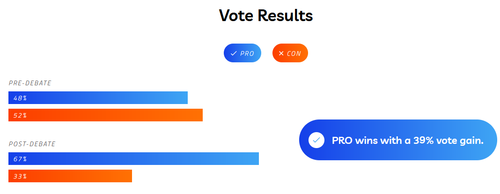Like scientists, journalists should be able to reproduce each other’s work in the lab. With too many anonymous sources, this becomes impossible.

By Tyler Durden: On Wednesday night, veteran journalist Matt Taibbi and bestselling UK author Douglas Murray mopped the floor in a Munk debate over why public trust in mainstream media has fallen to an all-time low. Their opponents, Canadian journalist Malcom Gladwell and the New York Times' Michelle Goldberg, were... shall we say, unpersuasive in their arguments that essentially boiled down to 'so what if we get a ton of stuff wrong, when it comes to the big picture, we get it right!'
Prior to the debate, Taibbi and Douglas weren't expected to win... however a post-debate poll gave the two a massive victory.
One point Taibbi made is that mainstream outlets have become a "Demographic hunting business" for which "ethical guardrails have been tossed out."
"You feed the audience news you know they will like," Taibbi said.
We agree wholeheartedly - though ZeroHedge strives to call out bullshit on all sides of every aisle, while at the same time being extremely clear on where we stand.

You can read Taibbi's entire opener below...

“Be it resolved: don’t trust mainstream media.” My name is Matt Taibbi, I’ve been a reporter for 30 years, and I argue for the resolution. You should not trust mainstream media.
I grew up in the press. My father was a reporter. My stepmother was a reporter. My godparents were reporters. Every adult I knew growing up seemed to be in media. I even used my father’s TV mic flag as a toy. I’d go in the backyard, stand with my back to the house, and play “live shot”:
Chet, I'm in Norwell, Massachusetts, where firefighters are battling a three-alarm blaze...
I love the news business. It’s in my bones. But I mourn for it. It’s destroyed itself.
My father had a saying: “The story’s the boss.” In the American context, if the facts tell you the Republicans were the primary villains in this or that disaster, you write that story. If the facts point more at Democrats, you go that way. If it turns out they’re both culpable, as was often the case for me across nearly ten years of investigating Wall Street and the causes of the 2008 crash for Rolling Stone, you write that. We’re not supposed to nudge facts one way or another. Our job is to call things as we see them and leave the rest up to you.
We don’t do that now. The story is no longer the boss. Instead, we sell narrative, as part of a new business model that’s increasingly indifferent to fact.
When there were only a few channels, the commercial strategy of news companies was to aim for the whole audience. A TV news broadcast aired at dinnertime and was designed to be consumed by the whole family, from your crazy right-wing uncle to the sulking lefty teenager. This system had its flaws. However, making an effort to talk to everybody had benefits, too. For one, it inspired more trust. Gallup polls twice showed Walter Cronkite of CBS to be the most trusted person in America. That would never happen today.
After the Internet arrived and flooded the market with new voices, some outlets found that instead of going after the whole audience, it made more financial sense to pick one demographic and dominate it. How? That’s easy. You feed the audience news you know they will like. When Fox had success targeting suburban and rural, mostly white, mostly older conservatives – the late Fox News chief Roger Ailes infamously described his audience as “55 to dead” – other companies soon followed suit.
Now everyone does it. Whether it’s Fox, or MSNBC, or CNN, or the Washington Post, nearly all Western media outlets are in the demographic-hunting business. This may be less true in Canada, where there’s a stronger public media tradition, but in the U.S., it’s standard.
Call it the “audience-optimization” model: instead of starting with a story and following the facts, you start with what pleases your audience, and work backward to the story. In this system, the overwhelming majority of national media organizations cater to one “side” or the other. For instance, according to a Pew Center survey from a few years ago, 93% of Fox’s audience votes Republican, while in an exactly mirroring phenomenon, MSNBC’s audience is 95% Democratic.
Our colleagues on the other side tonight represent two once-great media organizations. Michelle, the Pew survey says the audience for your New York Times is now 91% comprised of Democrats. Malcolm, the last numbers I could find for the New Yorker were back in 2012, and even then, only 9% of the magazine’s readers were Republicans. I imagine that number is smaller now.
This bifurcated system is fundamentally untrustworthy. When you decide in advance to forego half of your potential audience, to fulfill the aim of catering to the other half, you’re choosing in advance which facts to emphasize and which to downplay. You’re also choosing which stories to cover, and which ones to avoid, based on considerations other than truth or newsworthiness.
This is not journalism. It’s political entertainment, and therefore unreliable.
With editors now more concerned with retaining audience than getting things right, the defining characteristic across the business — from right to left — is inaccuracy. We just get a lot of stuff wrong now. It’s now less important for reporters to be accurate than “directionally” correct, which in center-left “mainstream” media mostly comes down to having the right views, like opposing Donald Trump, or anti-vaxxers, or election-deniers, or protesting Canadian truckers, or any other people deemed wrongthinkers.
In the zeal to “hold Trump accountable,” or oppose figures like Vladimir Putin, ethical guardrails have been tossed out. Silent edits have become common. Serious accusations are made without calling people for comment. Reporters get too cozy with politicians, and as a result report information either without attribution at all or sourced to unnamed officials or “people familiar with the matter.” Like scientists, journalists should be able to reproduce each other’s work in the lab. With too many anonymous sources, this becomes impossible.
We had an incident a few weeks ago where the lede of a wire service story read, “A senior U.S. intelligence official says Russian missiles crossed into NATO member Poland.” That’s the kind of story where if you get it wrong, you can start a war, but they still put all their chips on one unnamed source. That’s very risky practice even if you’re right.
That story turned out to be wrong, which sadly is no longer uncommon. In the Trump years an extraordinary number of “bombshells” went sideways. From the “pee tape” to the Alfa Server story to speculation that Trump was a Russian spy (recruited before disco) to false reports of Russians hacking a Vermont utility to an evidence-free story about Trump’s campaign manager somehow sneaking undetected to meet the most watched human on earth, Julian Assange in the Ecuadorian embassy in London, we’ve accumulated piles of wrong stories.
I’m no fan of Donald Trump. I wrote a book about the man called Insane Clown President. But I’ve compiled a list of over 100 of these “bombshells” that went belly up, from “Bountygate” to MSNBC saying Russian oligarchs co-signed a loan for Trump to countless others, because these stories offend me. A good journalist should always be ashamed of error. It bothers me to see so many of my colleagues so unashamed.
This by the way isn’t a wholly new phenomenon. After the WMD fiasco American news media didn’t do a self-audit. Instead we promoted the people who got it wrong and fired the ones who didn’t.
The excuse, “At least we’re not Breitbart,” doesn’t even hold. Think about another of these bombshells, the one in which Trump’s lawyer Michael Cohen supposedly went to Prague to meet with Russian hackers. This story came from the now-disgraced dossier of former British spy Christopher Steele. It’s been refuted multiple times, including by Special Counsel Robert Mueller, who flatly declared Cohen “never traveled to Prague.” Yet the tale will not die.
From MSNBC to CNN to McClatchy we’ve had leading media outlets continue to take seriously the idea that Donald Trump’s lawyer traveled to Prague to scheme with “Kremlin Representatives” over how to fix the election using Romanian hackers, who according to Steele would afterward retreat to Bulgaria, and use that country as a “bolt hole” to “lie low.” If that’s not a conspiracy theory, I don’t know what is.
This story is every bit as nuts as the idea that the 2020 election was stolen. I would venture to say it’s crazier. It’s at least more creative. No serious journalist would go near a story like this without a lot of evidence. Yet our leading media people believed it with none. Because they’re not doing journalism. They’re selling narrative, and this was good narrative.
News media shouldn’t have a “side.” The press has to be seen as separate from politics, not just because this is a crucial component of trustworthiness, but also because the media derives all its power from the perception of its independence. If a news organ is seen as too connected to one or another party, it loses its ability to serve as a check on power. How can you “hold Trump accountable” without credibility?
Getting things right is hard enough. The minute we try to do anything else in this job, the wheels come off. Until we get back to the basics, we don’t deserve to be trusted. And we won’t be.
No comments:
Post a Comment